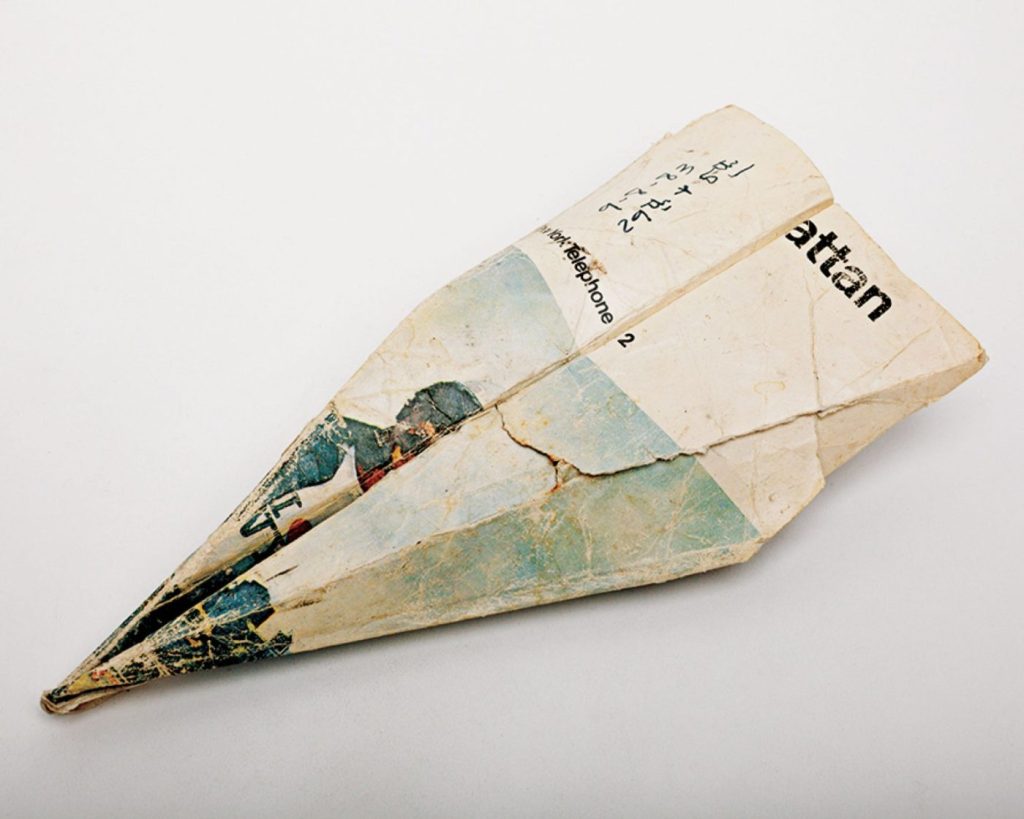…my free drift … Halts not particularly, But flies an eagle flight, bold and forth on,
Leaving no tract behind.
W. Shakespeare Timon of Athens, Act 1 Scene 1

How information circulates is odd. This paper plane is from a collection by Harry Everett Smith. He was a Beat anthropologist, much admired, but very bearded and earnest. One source notes that “it is suggested that Harry enjoyed alcohol, cannabis, Desoxyn, dewamesk, hashish, LSD, mescaline, peyote, psilocybin ..” and that he had “difficulty maintaining a normal ordered life”. Those two observations may be connected.
I’d never heard of dewamesk, by the way, and I’d barely heard of him. Dewamesk is an edible spread containing pistachios, orange peel, butter, cinnamon, sugar, nutmeg, cloves and quite a lot of hashish. Stoner jam, in other words, and since we are still just about in marmalade-making season, it will probably be available at your nearest chi-chi deli. Dewamesk (it’s spelt in various ways) was roundly praised years before Smith tried it by Théophile Gautier, founder of the Club des Hachichins, who called it “an emerald which gave off millions of tiny sparkles” and was disappointed that Baudelaire sniffed it without taking any[1].
I wrote that I had barely heard of Harry Smith. The context in which I had is that he was the collector and editor of the Anthology of American Folk Music, culled from his own collection of old records and issued at first on Folkways records in 1952. The importance of the Anthology needs to be underlined: it was the means of introducing then deeply obscure musicians such as Blind Lemon Jefferson or the Carter Family to the new folkie crowd in 1950s and 1960s Greenwich Village. In typical fashion, Smith didn’t have the rights to most of the songs he re-released (he just owned the records with those songs on them). Through the Anthology, though, however dubiously, Harry Smith provided the links between Alan Lomax and Bob Dylan or Joan Baez. I have been aware of him in that context for a long while. I didn’t know the rest, and that means I didn’t know the half of it.
Smith was interested in shamanism, in the tribes of the Pacific North-West, in alchemy and the Tarot. He was a film-maker and a sort of dotty inspiration to a cast of thousands.
Harry Smith must have been a nightmare to have around. He collected Ukrainian Easter eggs, apparently, as well as paper planes. His finances, diet, and conversational style were all unconventional. He was at one time such a tiresome houseguest of Allen Ginsberg that Ginsberg’s psychiatrist told him he had to move out because he was bad for Ginsberg’s blood pressure. Kudos ! Managing to stress the lugubrious beatnik is a huge feather in Smith’s cap.
Anyway, Smith used to rush out into the street to collect paper planes from wherever he found them, including rubbish bins. Some of that collection survived. Jason Fulford was invited to photograph them and they were collected into a book[2] then some of them were shown as an exhibition in Terminal 3 of San Francisco airport in the summer of 2016. The book is too expensive at the moment: more than £50.00 on amazon.com and obviously rare or rare-ish. There must be Harry Smith fans out there, which is a delight. Do note, by the way, that the book is called Volume 1 of Smith’s collections. Volume 2 (I kid you not at all), also illustrated by Fulford and credited to the same editorial team) deploys for your deep interest and intellectual gain Harry Everett Smith’s collections of … string doodles. How I wish there had been one of Martin Gardner’s great Mathematical Games columns (from the Scientific American, if you don’t know them) on those, and for all I know, perhaps there was one.

All of this I missed. There was an article in Wired. There was even an article in the New Yorker. Missed that, of course. I live in the UK and only see the New Yorker occasionally. Years passed.
Then a couple of days ago my news feed pinged up a reference from kottke.org : https://kottke.org/21/02/a-vintage-paper-airplane-collection . So here I am, incredibly late to the party, but now determined to find a cheap copy of Harry Everett Smith’s catalogue of paper planes, and very happy to join in circulating a little bit of information about him to those who may have missed him so far.
Is collecting paper planes a form of outsider art? A vernacular typology? A silly hobby or a manifestation of Obsessive-Compulsive Disorder? All of the above or none? I couldn’t care less. I’m glad Smith was drawn to doing it, glad that a number of people cared enough to keep the planes, glad that other people together with those same people were able to invite Jason Fulford to photograph them, glad that the photographs are so straightforwardly non-judgmental. Information has got to me the long way around. I guess I’m glad to catch up.
Harry Everett Smith (quite properly adhering to etiquette) died in the Chelsea Hotel. That was in 1991. Room number 328, before you ask. It seems appropriate when remembering Smith to remember the irrelevant details, too.
[1] « Mais l’idée de penser malgré lui-même le choquait vivement; on lui présenta du dawamesk, il l’examina, le flaira, et le rendit sans y toucher » Théophile Gautier, Notice sur Charles Baudelaire, in Œuvres Complètes de Charles Baudelaire, vol.1 : Les fleurs du Mal, 2nd edn., Paris, Lévy Frères, 1869, p.59
[2] John Klacsmann & Andrew Lampert (eds) Paper Airplanes – The Collections of Harry Smith: Catalogue Raisonné, Volume I. Photographs by Jason Fulford. Anthology Film Archives and J & L Books, 2015. ISBN 978-0989531139












